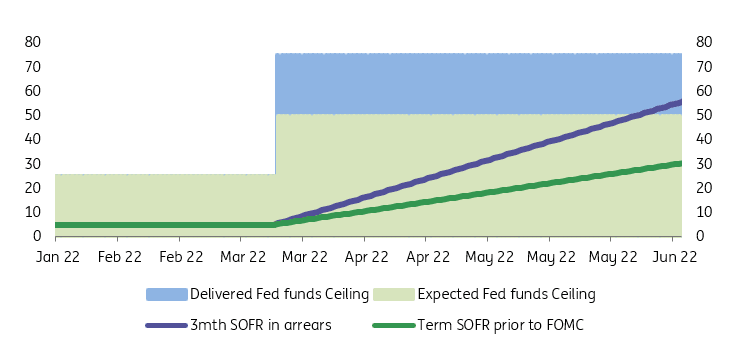The SOFR puzzle and how to solve it

Most new US dollar loans are being referenced to SOFR, but with more 'term-SOFR' take-up than expected. Yet, vanilla and cross-currency swaps are set exclusively 'in arrears'. While this points to imperfect hedges on many swap overlays, there are various basis swaps that help to square the circle.
New US dollar loans are choosing between term SOFR and SOFR in arrears
These are early days in the new loans market following the transition away from Libor (the London Inter-Bank Offered Rate). A few questions are being answered. What are borrowers choosing to reference their loans against? The answer: mostly SOFR (Secured Overnight Financing Rate). That's the easy bit. But are loans being referenced to "term SOFR" or "SOFR in arrears"? It's broadly split so far, but there are nuances.
See here for more on the distinction between the two, but suffice it to say that the official sector prefers SOFR in arrears as there is no guesswork to its derivation. There's nothing wrong with term SOFR though. The official sector certainly prefers uptake of this to the uptake of alternative credit-sensitive rates that they suggest smell like Libor. Term SOFR is effectively a fair value guess on where SOFR in arrears gets to.
The difference between the two at the payment date will typically be minor. But it can be large where there are surprise official rate moves. Note that the deviation could be quite significant on, for example, 12mth term rates, as here changes from the expected path of rates can deviate dramatically; rate change surprises happen.
The illustration below, for example, is a scenario where the Fed delivers a surprise 50bp rate hike from the 16 March 20022 Federal Open Market Committee (FOMC) meeting. With the market positioned for a 25bp hike, we find that 3mth term SOFR on the day before the meeting is a full 25bp above the delivered SOFR in arrears delivered on 15 June (3mths ahead). Whereas if the Fed delivered the expected 25bp hike, term SOFR payable on 15 June would equal in arrears SOFR for the same date.
How term SOFR deviates from SOFR in arrears if the Fed surprises with a 50bp hike in March (bp)
Source: ING estimates
Our experience so far shows that the market is broadly split between term SOFR and SOFR in arrears. SOFR in arrears is just about in the lead for new products, while term SOFR is more popular for re-papering of legacy products. But we’ve been surprised at the proportion of usage of term SOFR generally, beyond trade finance and working capital solutions that have always voiced a preference for term rates for practical reasons.
Some would argue that a decent ratio of term SOFR loans makes sense – after all, it was the reference rate of choice for legacy loans being transitioned away from Libor. At the same time, this could be explained away by a preference to maintain the characteristic of Libor-based legacy loans, as Libor too is a term rate.
The counter is that the bulk of derivative volumes are in SOFR in arrears, and this is expected to be sustained. This opens up some complications for derivative overlays.
Cross-currency swaps are exclusively set with reference to risk-free rates in arrears
This brings us to a second interesting theme. The bulk of the fixed versus float swaps market is now being set with reference to risk-free rates in arrears. This is also the case in cross-currency swaps. Traditionally this was centred on Libor on both legs. Now it's dominated by a risk-free rate on both legs. In fact, this is where the liquidity exclusively is.
This does not surprise us, as it was clear to us that there needed to be one style of cross-currency swap to support liquidity and maximise transparency.
This may be obvious for, say, a SOFR vs Sonia cross-currency swap where all new business cannot reference Libor (barring exceptions). But crucially it also applies to US dollar (USD) vs euro (EUR) cross-currency swaps where the default is SOFR vs Euro Short-Term Rate (ESTR), and not vs the Euro Interbank Offered Rate (Euribor), which has been reformed and remains in place and thus theoretically could be used on a cross-currency derivative. Anything else is effectively tailor-made.
In addition, cross-currency swaps are set predominantly with a reference to the "in arrears" versions of risk-free rates. The same is the case for vanilla single currency fixed to float swaps i.e. they use the in-arrears structure as the base floating rate, whether 3mth SOFR or 12mth ESTR, etc. This is an important nuance to be taken into consideration for players that are choosing to employ "term" risk-free rates for their underlying loans.
Swapping a loan referencing 6mth Euribor to 3mth SOFR in arrears
Source: ING estimates
Players can square between term and in-arrears and other rates through basis swaps
A few issues arise from this. If a decent rump of new USD loans are being referenced to term SOFR, what do such players do should they wish to add a derivatives overlay, when such an overlay would be set with reference to SOFR in arrears?
And what do loan players do with a Euribor referenced product if they wish to swap to say USD or British pound sterling (GBP) etc, where the cross-currency swap references ESTR (and not Euribor)?
There are two answers to this. One is to simply hedge with what’s available and accept the basis risk (implicitly assume the basis remains constant).
The alternative is to hedge the basis, by adding a suitable basis swap to complete the transition. So for example, and as illustrated above, a loan referencing Euribor can be swapped to SOFR by first swapping it to ESTR through a Euribor to ESTR swap, and then from there transition to ESTR to SOFR on a cross-currency swap.
The same adjustment can be made should a loan referencing term SOFR be required to swap to fixed SOFR. First swap the loan from term SOFR to SOFR in arrears, and then swap that to fixed SOFR. It’s technically a tad clunky as there are two legs, but it is perfectly doable, and the market is currently set up to do it this way.
Swapping from term SOFR to fixed rate SOFR
Source: ING estimates
At the moment this two-step approach is more likely to persist than the development of a term SOFR swap curve, but in reality brokers and dealers will be in a position to simply offer the package as one all-in swap.
Theoretically, as we progress out the SOFR in arrears swap curve there should be minimal deviation with a term SOFR swap curve. In the end, they are both projecting the same thing (overnight SOFR), and a fixed long tenor SOFR in arrears rate is in effect a long term SOFR rate (both are educated guesses).
And there are choices beyond SOFR for players that like to include credit sensitivity
There is a third dimension worth mentioning here – other rates beyond SOFR. For example, the Bloomberg Short-Term Bank Yield Index (BSBY).
Players that choose to use BSBY as a reference rate for loans do have a fixed to float derivatives market to trade off. And as BSBY is a term rate, it would need to be swapped to SOFR in arrears should there be a requirement to swap it into another currency if a perfect hedge is to be realised without basis risk.
Alternatives are also available in other products, in the guise of the likes of Ameribor (American Interbank Offered Rate), IHS and AXI. For pure loans, these alternatives offer a menu of choice. Players can choose to link their loans to a different version of a credit-sensitive rate, or they can construct their own by adding a credit spread adjustment on to SOFR.
Read the original analysis: The SOFR puzzle and how to solve it
Author

ING Global Economics Team
ING Economic and Financial Analysis
From Trump to trade, FX to Brexit, ING’s global economists have it covered. Go to ING.com/THINK to stay a step ahead.




















